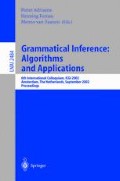Abstract
In this article, the current implementation of the Alignment-Based Learning (ABL) framework (van Zaanen, 2002) will be described. ABL is an unsupervised grammar induction system that is based on (1951) idea of substitutability. Instances of the framework can be applied to an untagged, unstructured corpus of natural language sentences, resulting in a labelled, bracketed version of that corpus. Firstly, the framework aligns all sentences in the corpus in pairs, resulting in a partition of the sentences consisting of parts of the sentences that are equal in both sentences and parts that are unequal. Since substituting one unequal part for the other results in another valid sentence, the unequal parts of the sentences are considered to be possible (possibly overlapping) constituents. Secondly, of all possible constituents found by the first phase, the best are selected.
Access this chapter
Tax calculation will be finalised at checkout
Purchases are for personal use only
Bibliography
ACL (1997) Proceedings of the 35th Annual Meeting of the ACL and the 8th Meeting of the EACL; Madrid, Spain. ACL.
Bonnema, R., Bod, R., and Scha, R. (1997). A DOP model for semantic interpretation. In ACL (1997), pages 159–167.
Collins, M. (1997). Three generative, lexicalised models for statistical parsing. In ACL (1997), pages 16–23.
Harris, Z. S. (1951). Structural Linguistics. University of Chicago Press, Chicago:IL, USA and London, UK, 7th (1966) edition.
Marcus, M., Santorini, B., and Marcinkiewicz, M. (1993). Building a large annotated corpus of English: the Penn treebank. Computational Linguistics, 19(2):313–330.
van Zaanen, M. (2002). Bootstrapping Structure into Language: Alignment-Based Learning. PhD thesis, University of Leeds, Leeds, UK.
Author information
Authors and Affiliations
Editor information
Editors and Affiliations
Rights and permissions
Copyright information
© 2002 Springer-Verlag Berlin Heidelberg
About this paper
Cite this paper
van Zaanen, M. (2002). Implementing Alignment-Based Learning. In: Adriaans, P., Fernau, H., van Zaanen, M. (eds) Grammatical Inference: Algorithms and Applications. ICGI 2002. Lecture Notes in Computer Science(), vol 2484. Springer, Berlin, Heidelberg. https://doi.org/10.1007/3-540-45790-9_30
Download citation
DOI: https://doi.org/10.1007/3-540-45790-9_30
Published:
Publisher Name: Springer, Berlin, Heidelberg
Print ISBN: 978-3-540-44239-4
Online ISBN: 978-3-540-45790-9
eBook Packages: Springer Book Archive

